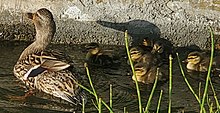Anatinae
| Dabbling ducks Temporal range:
| |
|---|---|

| |
| Pacific black duck (Anas superciliosa) | |
| Scientific classification | |
| Domain: | Eukaryota |
| Kingdom: | Animalia |
| Phylum: | Chordata |
| Class: | Aves |
| Order: | Anseriformes |
| Family: | Anatidae |
| Subfamily: | Anatinae Leach, 1820 |
| Type species | |
| Genera | |
|
See text | |
The Anatinae are a
There has been much debate about the systematical status and which ducks belong to the Anatinae. Some taxonomic authorities only include the dabbling ducks and their close relatives, the extinct moa-nalos. Alternatively,[1] the Anatinae are considered to include most "ducks", and the dabbling ducks form a tribe Anatini within these. The classification as presented here more appropriately reflects the remaining uncertainty about the interrelationships of the major lineages of Anatidae (waterfowl).[2]
Systematics
This section needs additional citations for verification. (September 2011) |
The dabbling duck group, of worldwide distribution, was delimited in a 1986 study[3] to include eight genera and some 50–60 living species. However, Salvadori's teal is almost certainly closely related to the pink-eared duck, and other genera are likewise of unresolved affiliation.[2][4] The peculiar marbled duck, formerly tentatively assigned to the dabbling ducks, is thought to be a diving duck or even a distinct subfamily.[2]
This group of ducks has been so named because its members feed mainly on vegetable matter by upending on the water surface, or grazing, and only rarely diving. These are mostly gregarious ducks of freshwater or estuaries. These birds are strong fliers and northern species are highly migratory. Compared to other types of duck, their legs are located more towards the centre of their bodies. They walk well on land, and some species feed terrestrially.
"Puddle ducks" generally feed on the surface of the water or feed on very shallow bottoms. They are not equipped to dive down several feet like their diving counterparts. The most prominent difference between puddle ducks and divers is the size of the feet. A puddle duck's feet are generally smaller because they do not need the extra propulsion to dive for their forage.
Another distinguishing characteristic of puddle ducks when compared with diving ducks is the way in which they take flight when spooked or are on the move. Puddle ducks spring straight up from the water, but diving ducks need to gain momentum to take off, so they must run across the water a short distance to gain flight.
History of classification
Traditionally, most ducks were assigned to either the
As for the
In addition, the genus

Genera


The following genera are (with one exception) unequivocal dabbling ducks:
- Amazonetta– status not fully resolved, most likely a dabbling duck
- Sibirionetta – Baikal teal
- Spatula
- Mareca
- Lophonetta – crested duck
- Speculanas –bronze-winged duck
- Anas

The three known genera and four known species of moa-nalos all became extinct around AD 1000. They formerly occurred on the Hawaiian Islands and were derived from dabbling ducks, possibly even from a close ancestor of the mallard:
- Chelychelynechen
- Thambetochen
- Ptaiochen



Another bizarre insular anatine was
Frequently placed into the Anatinae are these genera, whose relationships must be considered uncertain at present:
- †Chenoanas?
- †Dunstanetta (Johnstone's duck)
- †Lavadytis
- †Pinpanetta
- †Tirarinetta
- Oxyurini (stiff-tailed ducks)
- Heteronetta(black-headed duck)
- Nomonyx(masked duck)
- Oxyura
- Biziura – Oxyurini?
- Aix– Tadorninae?
- paraphyletic, with one species in Tadorninae and the other closer to diving ducks
- Callonetta– Tadorninae?
- Chenonetta – Tadorninae?
- Cyanochen
- Nettapus – part of ancient Gondwananlineage?
- Mergini - (seaducks)
- †Chendytes
- †Shiriyanetta
- Polysticta
- Somateria
- Histrionicus
- †Camptorhynchus
- Melanitta
- Clangula
- Bucephala
- Mergellus?
- Lophodytes?
- Mergus?
On the other hand, the following genera, usually considered to belong into the Tadorninae, may actually be dabbling ducks:
- Sarkidiornis
- Tachyeres
References
- ISBN 0-517-03288-0
- ^ JSTOR 4089339.
- ^ .
- .
- ^ Steadman, David William (1999). "The Prehistory of Vertebrates, Especially Birds, on Tinian, Aguiguan, and Rota, Northern Mariana Islands" (PDF). Micronesica. 31 (2): 319–345. Archived from the original (PDF) on 2004-07-05.
- JSTOR 3100038.
